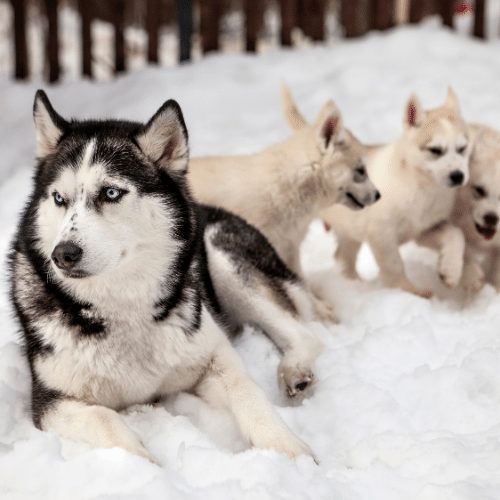Female dogs are generally too old to breed after the age of 7 to 8 years. At this age, they are at higher risk of complications during pregnancy and delivery.
Breeding a female dog beyond the age of 7 to 8 years can pose significant health risks to both the mother and the puppies. These risks include difficulties during labor, higher chances of stillbirth, and an increased likelihood of health issues in the puppies.
It’s essential for dog breeders and owners to prioritize the health and well-being of the female dog when considering breeding, and to consult with a veterinarian to determine the best age for breeding based on the individual dog’s health and condition. Taking such precautions can ensure a safer and healthier breeding process for both the female dog and her offspring.

Credit: toegrips.com
Factors Affecting Female Dog’s Breeding Age
Factors such as overall health, genetics, and age play a crucial role in determining when a female dog is too old to breed. These factors can vary from dog to dog, so it is important to consult with a veterinarian to determine if it is safe for a specific dog to continue breeding.
Factors Affecting Female Dog’s Breeding AgePhysical HealthA female dog’s physical health is one of the primary factors affecting her breeding age. Just like humans, dogs also experience age-related changes that can impact their ability to conceive and sustain a pregnancy. As a dog ages, her reproductive system undergoes natural wear and tear. It’s crucial to ensure that the dog is in good physical condition before considering breeding her. Regular check-ups with a veterinarian are essential to assess her overall health status, including any underlying conditions that may affect her reproductive capabilities.Reproductive HealthReproductive health plays a vital role in determining a female dog’s breeding age. Factors such as the regularity of her heat cycles, presence of any infections or diseases in her reproductive organs, and the quality of her eggs can affect her fertility. As a dog gets older, the quality of her eggs tends to decline, potentially leading to a decreased chance of successful fertilization and conception. Ensuring the reproductive health of a female dog involves regular monitoring of her heat cycles and conducting appropriate tests to identify any reproductive issues that may hinder her ability to breed.Breeding HistoryAnother critical factor to consider when determining a female dog’s breeding age is her breeding history. If she has previously had multiple successful litters and has experienced conventional pregnancies and deliveries without complications, she may be considered for further breeding even at an advanced age. However, if there have been instances of reproductive difficulties, such as failed pregnancies or complicated deliveries, it may be advisable to retire her from breeding earlier. The history of a female dog’s breeding performance provides valuable insights into her reproductive capabilities and overall suitability for future breeding.Taking these factors into account can help determine when a female dog may be too old to breed. It’s essential to prioritize both the physical and reproductive health of the dog to ensure successful pregnancies and the well-being of both the mother and her offspring. Regular veterinary check-ups, monitoring of heat cycles, and a thorough assessment of the dog’s breeding history are crucial in making an informed decision about her breeding age.| Factors Affecting Female Dog’s Breeding Age |
|---|
| Physical Health |
| Reproductive Health |
| Breeding History |

Credit: toegrips.com
Signs Of Being Too Old To Breed
Decreased Fertility
As a female dog ages, her fertility naturally decreases. This decline can affect her ability to conceive and carry a litter to full term, increasing the risk of complications for both the mother and the puppies.
Chronic Health Issues
Older female dogs are more prone to develop chronic health problems such as arthritis, diabetes, and cardiac issues. These conditions can significantly impact their ability to withstand the physical demands of pregnancy and nursing.
Lack Of Interest In Mating
When a female dog shows a lack of interest in mating or becomes disengaged during the breeding process, it may be a sign that she is no longer suited for breeding. This disinterest can be a result of hormonal changes and declining reproductive capabilities.
Responsible Breeding Practices
Responsible breeding practices are essential to ensure the health and well-being of female dogs throughout their breeding years. This involves careful consideration of health screening, monitoring reproductive cycles, and retirement planning. By prioritizing responsible breeding practices, breeders can help to maintain the quality and health of their breeding lines for future generations.
Health Screening
Health screening is a fundamental aspect of responsible breeding. Before breeding an older female dog, it is crucial to conduct comprehensive health screenings to assess her overall health status. These screenings should include evaluations for genetic conditions, hip dysplasia, and other potential hereditary health issues. By prioritizing health screening, breeders can ensure that the female dog is in proper physical condition for breeding, reducing the risk of passing on genetic health problems to her offspring.
Monitoring Reproductive Cycles
Regular monitoring of a female dog’s reproductive cycles is essential for successful and responsible breeding. It is important to monitor the timing and frequency of heat cycles to determine the optimal time for breeding. Additionally, continuous veterinary supervision during the breeding process can help to mitigate potential complications and ensure the overall health and safety of the dog and her puppies. By maintaining strict oversight of reproductive cycles, breeders can enhance the likelihood of successful breeding outcomes and minimize associated risks.
Retirement Planning
As a female dog ages, retirement planning becomes a vital consideration for responsible breeding practices. Breeders should establish a retirement plan to determine the appropriate age for a female dog to transition out of breeding. This plan should prioritize the dog’s well-being by allowing her to enjoy a comfortable and stress-free retirement. Furthermore, retirement planning ensures that older female dogs are given the opportunity to live out their golden years in a loving and caring environment, free from the demands of breeding. By proactively addressing retirement, breeders can uphold the ethical treatment of their breeding animals and maintain the overall welfare of their breeding program.

Credit: spiritdogtraining.com
Potential Risks Of Breeding An Older Female Dog
Potential Risks of Breeding an Older Female Dog
When considering breeding a female dog, it is important to understand the potential risks associated with breeding an older dog. While it may be tempting to breed your dog in her later years, it is crucial to be aware of the potential complications that can arise. These risks can have serious consequences for both the mother and her puppies. In this article, we will discuss three major risks associated with breeding an older female dog: complications during pregnancy, higher chances of stillbirth or pup mortality, and health risks for the mother.
Complications During Pregnancy
Breeding an older female dog can increase the likelihood of overall complications during pregnancy. As dogs age, they may experience decreased fertility, making it more difficult for them to conceive. The risk of hormonal imbalances, uterine infections, and other reproductive issues also increases with age. These complications can make it challenging for the older dog to conceive and successfully carry her puppies to term.
Higher Chances Of Stillbirth Or Pup Mortality
One of the biggest risks involved in breeding an older female dog is the higher chances of stillbirth or pup mortality. As a dog ages, her eggs are more likely to have genetic abnormalities, which can lead to developmental issues in the puppies. Older dogs also face a higher risk of complications during the delivery process, resulting in stillborn or weak puppies. This can be emotionally devastating for both the breeder and the mother dog.
Health Risks For The Mother
Breeding can take a toll on a dog’s physical health, especially when she is older. The strain of pregnancy, labor, and nursing can exacerbate age-related conditions such as arthritis, joint problems, and respiratory issues. Older female dogs may also be more prone to developing life-threatening conditions such as eclampsia (milk fever) or pyometra (a uterine infection). These health risks not only pose a danger to the mother dog but can also put the survival of the puppies at risk.
Conclusion:
Considering the potential risks involved, it is important to carefully assess the age and health of a female dog before deciding to breed her. Breeding should always be done responsibly with the welfare of both the mother and her puppies in mind. It is advisable to consult with a veterinarian experienced in reproductive health to ensure the best possible outcome for all parties involved.
Alternatives For Older Female Dogs
Female dogs have age limits for breeding, and it’s crucial to know when it’s too late. Discover alternative ways to care for older female dogs without putting their health at risk.
When a female dog reaches a certain age, it may not be safe or healthy for her to continue breeding. In such cases, there are several alternatives that pet owners can consider to ensure the well-being of their older female dogs. These alternatives include:
Spaying To Prevent Health Issues
Spaying is a surgical procedure that involves removing the uterus and ovaries of a female dog. This not only prevents further breeding but also offers numerous health benefits. By spaying an older female dog, you can significantly reduce the risk of uterine infections, mammary tumors, and other reproductive diseases that commonly affect intact female dogs. It is always recommended to consult with a veterinarian to determine the best age and timing for spaying your older female dog.
Adopting Or Fostering
Another alternative for older female dogs that are no longer suitable for breeding is to consider adoption or fostering. Many shelters and rescue organizations are always in need of loving homes for mature dogs. By opening your home to an older female dog, you can provide a comfortable and secure environment for her to live out her golden years. Adoption or fostering not only gives these dogs a second chance at a happy life but also brings immense joy and companionship to your home.
Educating And Raising Awareness
One effective way to address the issue of older female dogs being bred unsuitably is by educating and raising awareness among pet owners. Many people may not be aware of the potential health risks associated with breeding older female dogs. By sharing information on the importance of responsible breeding practices and the potential health issues that can arise, we can help prevent unnecessary breeding of older female dogs. Spreading awareness through online platforms, social media, and local community events can make a significant difference in promoting the well-being of older female dogs.
Frequently Asked Questions On When Is A Female Dog Too Old To Breed
Can Old Female Dogs Still Get Pregnant?
Yes, old female dogs can still get pregnant. However, as dogs age, their fertility decreases, increasing the risk of complications during pregnancy and birth. It is advisable to consult with a veterinarian to assess the dog’s health and determine if it is safe for her to breed.
What Are The Risks Of Breeding An Old Female Dog?
Breeding an old female dog poses several risks, including a higher chance of birth defects, stillborn puppies, or complications during labor. Aging dogs may also have underlying health conditions that can be exacerbated by pregnancy. It is crucial to consider the dog’s overall health and consult with a veterinarian before making any breeding decisions.
At What Age Is A Female Dog Considered Too Old To Breed?
There is no definitive age when a female dog is considered too old to breed, as it varies based on individual health and breed. However, most experts recommend retiring female dogs from breeding around 5 to 7 years old. It is best to consult with a veterinarian who can assess the dog’s specific condition and advise on the appropriate age to stop breeding.
Conclusion
Female dogs, like all living beings, have an optimal age for breeding. It is crucial to consider their overall health and well-being before making any breeding decisions. Understanding the risks and potential complications associated with breeding an older female dog is essential to ensure the safety of both the mother and the puppies.
Always consult with a veterinarian to determine if your female dog is too old to breed and to explore other alternatives for preserving her lineage. Your dog’s health and happiness should always be the top priority.



